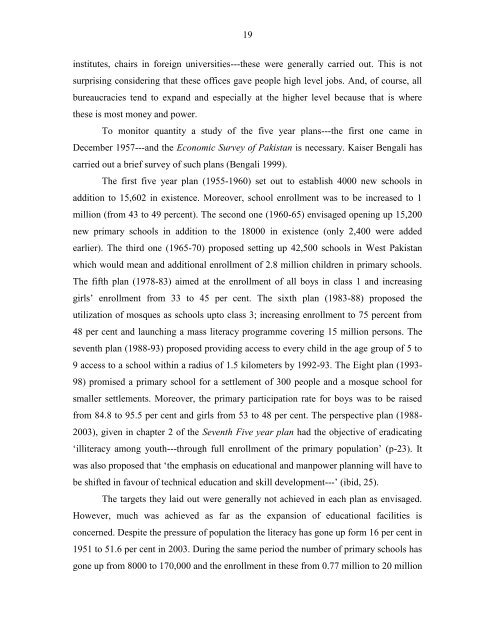DENIZENS OF ALIEN WORLDS
danizen1
danizen1
- No tags were found...
You also want an ePaper? Increase the reach of your titles
YUMPU automatically turns print PDFs into web optimized ePapers that Google loves.
19<br />
institutes, chairs in foreign universities---these were generally carried out. This is not<br />
surprising considering that these offices gave people high level jobs. And, of course, all<br />
bureaucracies tend to expand and especially at the higher level because that is where<br />
these is most money and power.<br />
To monitor quantity a study of the five year plans---the first one came in<br />
December 1957---and the Economic Survey of Pakistan is necessary. Kaiser Bengali has<br />
carried out a brief survey of such plans (Bengali 1999).<br />
The first five year plan (1955-1960) set out to establish 4000 new schools in<br />
addition to 15,602 in existence. Moreover, school enrollment was to be increased to 1<br />
million (from 43 to 49 percent). The second one (1960-65) envisaged opening up 15,200<br />
new primary schools in addition to the 18000 in existence (only 2,400 were added<br />
earlier). The third one (1965-70) proposed setting up 42,500 schools in West Pakistan<br />
which would mean and additional enrollment of 2.8 million children in primary schools.<br />
The fifth plan (1978-83) aimed at the enrollment of all boys in class 1 and increasing<br />
girls‘ enrollment from 33 to 45 per cent. The sixth plan (1983-88) proposed the<br />
utilization of mosques as schools upto class 3; increasing enrollment to 75 percent from<br />
48 per cent and launching a mass literacy programme covering 15 million persons. The<br />
seventh plan (1988-93) proposed providing access to every child in the age group of 5 to<br />
9 access to a school within a radius of 1.5 kilometers by 1992-93. The Eight plan (1993-<br />
98) promised a primary school for a settlement of 300 people and a mosque school for<br />
smaller settlements. Moreover, the primary participation rate for boys was to be raised<br />
from 84.8 to 95.5 per cent and girls from 53 to 48 per cent. The perspective plan (1988-<br />
2003), given in chapter 2 of the Seventh Five year plan had the objective of eradicating<br />
‗illiteracy among youth---through full enrollment of the primary population‘ (p-23). It<br />
was also proposed that ‗the emphasis on educational and manpower planning will have to<br />
be shifted in favour of technical education and skill development---‘ (ibid, 25).<br />
The targets they laid out were generally not achieved in each plan as envisaged.<br />
However, much was achieved as far as the expansion of educational facilities is<br />
concerned. Despite the pressure of population the literacy has gone up form 16 per cent in<br />
1951 to 51.6 per cent in 2003. During the same period the number of primary schools has<br />
gone up from 8000 to 170,000 and the enrollment in these from 0.77 million to 20 million












